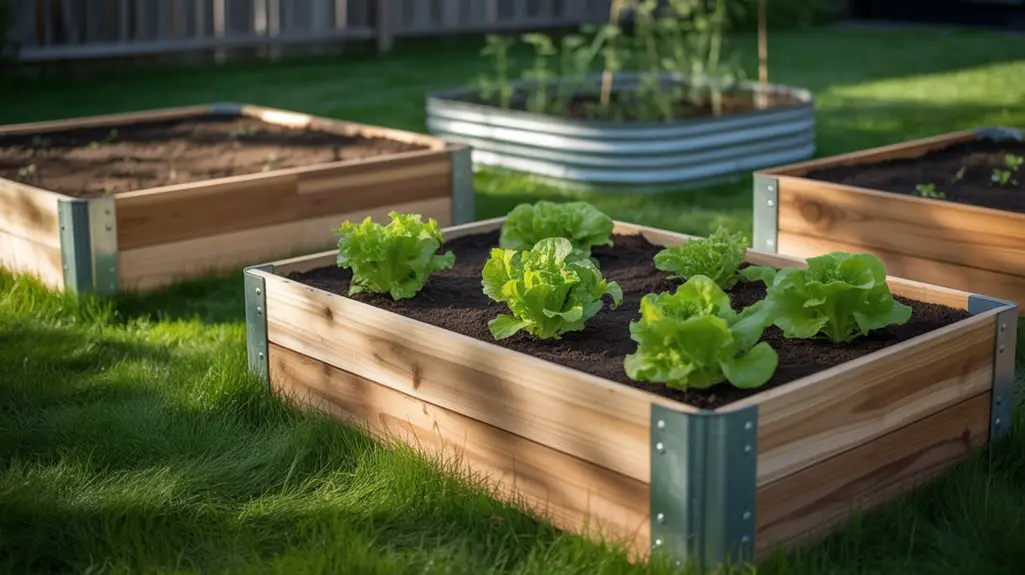Like ancient farmers who discovered the secrets of nature’s checks and balances, you can harness the power of companion planting to protect your garden from pests naturally. When you strategically pair compatible plants, you create a protective ecosystem where certain plants deter specific insects while others attract beneficial predators. This time-tested method reduces your need for chemical pesticides while improving plant health and yield. The right combinations can transform your garden’s resilience against common invaders.
The Science Behind Companion Planting
The science behind companion planting hinges on three key mechanisms: chemical deterrence, habitat diversification, and trap cropping.
Plants naturally produce biochemicals called allelochemicals that can repel specific insects. When you plant marigolds near vegetables, they release thiopene, which deters nematodes and other soil pests.
Diverse plantings disrupt pest feeding patterns by confusing insects that locate host plants through visual or olfactory cues. This ecological approach creates beneficial insect habitats that maintain natural predator-prey relationships.
Trap cropping works by deploying sacrificial plants that attract pests away from your main crops. For example, nasturtiums draw aphids away from your valuable vegetables, effectively serving as living insect management systems. Additionally, integrated pest management strategies often incorporate companion planting as a key component for enhancing overall garden health.
Top Companion Plant Pairings for Vegetable Gardens

Twelve essential companion plant pairings can dramatically improve both the health and productivity of your vegetable garden.
Plant tomatoes with basil to repel flies and mosquitoes while enhancing flavor. Pair carrots with onions to deter carrot flies. Cucumbers thrive alongside sunflowers, which provide shade and natural trellising.
Plant cabbage with aromatic herbs like thyme to repel cabbage moths.
Corn, beans, and squash form the traditional “Three Sisters” planting—corn supports beans, beans fix nitrogen, and squash suppresses weeds.
Marigolds protect nearly any vegetable from nematodes. Nasturtiums act as trap crops for aphids, protecting your brassicas.
Pair lettuce with tall plants for necessary afternoon shade. Garlic deters numerous pests when planted throughout your garden, while rosemary repels cabbage moths, bean beetles, and carrot flies. Additionally, incorporating organic pest control methods can further enhance your garden’s defenses against unwanted insects.
Herbs That Naturally Repel Garden Pests

Beyond companion plant pairings, herbs serve as powerful natural pest control agents in your garden ecosystem. Basil repels flies and mosquitoes while enhancing tomato flavor. Mint deters cabbage moths, ants, and rodents, but plant it in containers to control its spread. Rosemary emits a potent scent that repels cabbage loopers, carrot flies, and bean beetles. Lavender’s strong fragrance drives away fleas, moths, and mosquitoes while attracting pollinators. You’ll find that thyme deters cabbage worms and whiteflies, while dill attracts beneficial wasps that prey on caterpillars. Cilantro repels aphids, spider mites, and potato beetles when planted near vulnerable crops. Chives effectively combat aphids and Japanese beetles, particularly when surrounding rose bushes and vegetable plants. Incorporating native plants into your garden can further enhance the effectiveness of these herbs in attracting beneficial wildlife.
Flowers That Attract Beneficial Insects
Strategically planting flowers throughout your garden creates a haven for beneficial insects that naturally control pest populations.
Cosmos, sunflowers, and zinnias attract ladybugs that devour aphids, while sweet alyssum draws hoverflies whose larvae consume hundreds of pests daily.
Marigolds serve dual purposes by attracting parasitic wasps that target caterpillars while their roots repel nematodes.
Plant borage to invite pollinators and predatory insects, as its bright blue flowers bloom for months.
Phacelia, with its fern-like foliage and purple blooms, is particularly effective at attracting lacewings that feed on thrips, mites, and whiteflies.
For maximum impact, incorporate these flowers directly into your vegetable beds rather than isolating them.
You’ll create a self-regulating ecosystem where beneficial insects establish permanent populations, reducing your need for intervention. Additionally, creating a thriving herb garden can further enhance the diversity of beneficial insects in your garden.
Designing Your Garden Layout for Maximum Pest Protection
When planning your garden layout, consider both plant diversity and strategic positioning to create effective pest barriers. Arrange plants in guilds—clusters of mutually beneficial species—rather than isolated rows.
Place aromatic herbs like basil, rosemary, and thyme at the perimeter and between vegetable rows as natural pest deterrents.
Incorporate trap crops strategically by planting nasturtiums to attract aphids away from your main crops. Create beneficial insect highways by weaving flowering plants throughout your garden, ensuring consistent blooming periods from spring to fall.
Allow for adequate airflow between plants to reduce fungal issues while maintaining enough proximity for companion effects. Additionally, utilizing natural weed control methods can further enhance the health and productivity of your garden.
Don’t forget vertical space—trellised plants can shield ground crops, while taller companions like sunflowers can protect heat-sensitive varieties from excessive summer exposure.
Common Pests and Their Plant Nemeses
Every garden battles its own set of persistent invaders, but nature has provided plant allies that can help deter specific pests through chemical deterrents, masking scents, or habitat disruption.
For aphid control, plant nasturtiums, calendula, and marigolds strategically throughout your garden.
Cabbage moths retreat from the strong aromas of thyme, sage, and rosemary. Plant basil near tomatoes to repel hornworms, while cucumber beetles avoid radishes.
Carrot flies won’t approach your carrot beds when surrounded by onions, leeks, or rosemary. Slugs detest the scratchy surfaces of eggshells and rough-textured plants like comfrey.
Colorado potato beetles stay clear of catnip, tansy, and coriander. For broad-spectrum protection, aromatic herbs like mint, lavender, and lemon balm confuse many insect pests seeking their preferred hosts.
Seasonal Strategies for Companion Planting
Successful companion planting requires adapting your approach throughout the growing season’s distinct phases. You’ll need different companion configurations as temperatures and pest pressures change from spring through fall.
| Season | Primary Pests | Effective Companions |
|---|---|---|
| Spring | Cutworms, Aphids | Calendula, Chives, Radishes |
| Summer | Tomato Hornworms, Squash Bugs | Basil, Nasturtiums, Marigolds |
| Fall | Cabbage Moths, Aphids | Thyme, Dill, Garlic |
| Winter | Overwintering Pests | Cover crops, Mustard family |
During cool spring months, focus on fast-growing companions like radishes to deter early-season pests. Summer requires robust aromatic plants that manage peak insect populations. In fall, shift to hardy companions that protect late crops, while winter planning should incorporate cover crops that suppress dormant pest cycles. Additionally, consider implementing effective mulching techniques to further enhance the health of your plants and deter pests throughout the growing seasons.
Companion Planting Success Stories From Home Gardeners
Real-world experiences often provide the most compelling evidence for companion planting’s effectiveness against garden pests.
You’ll find that countless gardeners report dramatic success with strategic plant pairings. A Massachusetts gardener eliminated cabbage worm infestations by surrounding brassicas with aromatic herbs like thyme and rosemary.
In Arizona, a community garden reduced squash bug populations by 80% after interplanting nasturtiums with their cucurbits.
Tomato growers consistently praise marigolds for deterring nematodes, while many report that basil improves both flavor and pest resistance in neighboring tomato plants.
A Seattle gardener eliminated aphid problems by strategically placing alliums throughout her vegetable beds.
These testimonials reveal that companion planting isn’t just theory—it’s a practical approach that delivers tangible results in diverse growing conditions and microclimates. Additionally, pest-resistant gardens can enhance biodiversity, creating healthier ecosystems for plants to thrive.
Getting Started: Beginner-Friendly Companion Plant Combinations
Newcomers to companion planting can achieve immediate success with several foolproof plant pairings that effectively deter common pests.
Start with tomatoes and basil—this classic combination repels hornworms and mosquitoes while enhancing tomato flavor.
Plant marigolds throughout your garden to deter nematodes and aphids with their strong scent.
For your cucumber beds, add nasturtiums to draw aphids away from your main crop. They act as trap plants while adding edible flowers to your harvest.
Carrots and onions form another perfect beginner pairing—onions mask the scent that carrot flies detect, while carrots deter onion flies.
Incorporating natural pest control methods like companion planting not only keeps pests at bay but also promotes a healthier garden ecosystem.
You’ll see best results when you incorporate these companions at planting time.
Keep spacing requirements in mind, as overcrowding reduces effectiveness and may create competition for nutrients.
Conclusion
As you implement companion planting in your garden, you’ll witness nature’s symphony of protection unfold. Start with simple pairings and expand as you gain confidence. Remember, a thoughtfully designed garden isn’t just aesthetically pleasing—it’s a fortress against unwanted pests. By working with nature’s inherent relationships rather than against them, you’re creating a sustainable ecosystem that’ll reward you with healthier plants and abundant harvests.




